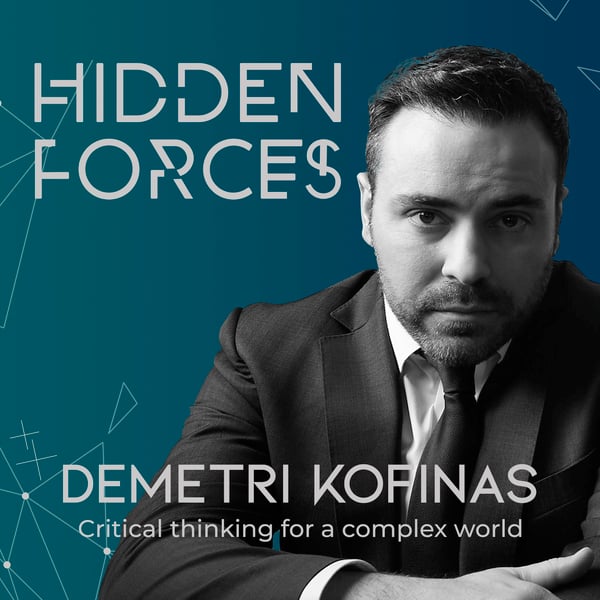How To Assess True Macroeconomic Risk | Philipp Carlsson-Szlezak
Hidden Forces
Demetri Kofinas
4.8 • 1.6K Ratings
🗓️ 8 July 2024
⏱️ 57 minutes
🧾️ Download transcript
Summary
In Episode 370 of Hidden Forces, Demetri Kofinas speaks with Philipp Carlsson-Szlezak, the Global Chief Economist at BCG and the author of “Shocks, Crises, and False Alarms,” about how to assess macroeconomic risk without relying on broken models, pervasive doom-mongering, and whipsawing data prints that have little to do with the structural drivers of economic and financial change.
The shocks and crises of recent years are a rude awakening for executives and investors who have spent the last 40 years operating in a relatively benign macroeconomic and political environment. This period of geopolitical convergence characterized by increased trade and capital flows, lengthening business cycles, declining interest rates, and stable inflation is over, forcing corporate leaders and investors alike to recognize that macroeconomic risk is now something that needs to be actively managed.
In the first hour, Demetri asks Philipp to explain his core framework of economic eclecticism, which relies on contextual flexibility, situational judgment, and rational optimism that neither ignores tail risks nor drags them to the center of the distribution.
They examine four case studies and their associated narratives to help us understand why so many predictions fail to materialize and how a more eclectic approach to macroeconomic risk assessment could have helped investors and business leaders avoid these pitfalls and take advantage of the economic and financial opportunities created by these events in real-time.
In the second hour, Philipp and Demetri discuss the role of government and central bank stimulus as a variable that needs to be actively managed by investors and business executives. They also discuss how to assess the risks associated with a U.S. government debt crisis, the integrity of the U.S. Dollar as a global reserve asset, and how to assess the prospects of technologically induced productivity growth, including AI-driven improvements to a service-oriented economy like the U.S.
You can subscribe to our premium content and access our premium feed, episode transcripts, and Intelligence Reports at HiddenForces.io/subscribe.
If you want to join in on the conversation and become a member of the Hidden Forces Genius community, which includes Q&A calls with guests, access to special research and analysis, in-person events, and dinners, you can also do that on our subscriber page at HiddenForces.io/subscribe.
If you enjoyed listening to today’s episode of Hidden Forces, you can help support the show by doing the following:
Subscribe on Apple Podcasts | YouTube | Spotify | Stitcher | SoundCloud | CastBox | RSS Feed
Write us a review on Apple Podcasts & Spotify
Subscribe to our mailing list at https://hiddenforces.io/newsletter/
Producer & Host: Demetri Kofinas
Editor & Engineer: Stylianos Nicolaou
Subscribe and Support the Podcast at https://hiddenforces.io
Join the conversation on Facebook, Instagram, and Twitter at @hiddenforcespod
Follow Demetri on Twitter at @Kofinas
Episode Recorded on 07/01/2024
Transcript
Click on a timestamp to play from that location
| 0:00.0 | What's up everybody? My name is Demetra Kaffenas and you're listening to Hidden Forces, a |
| 0:06.0 | podcast that inspires investors, entrepreneurs and everyday citizens to challenge |
| 0:12.0 | consensus narratives and learn how to think critically |
| 0:15.0 | about the systems of power shaping our world. |
| 0:18.4 | My guest in this episode of Hidden Forces is Philip Carlson Slezak, the global chief economist at BCG, and the author of a phenomenal |
| 0:26.4 | new book on macroeconomic risk titled Shocks, Crisies, and False Alarms, which is out this week. |
| 0:33.5 | The shocks and crises of recent years are a rude awakening for executives and investors who have |
| 0:38.9 | spent the last 40 years operating in a relatively benign macroeconomic and political environment of geopolitical convergence, |
| 0:46.0 | characterized by increased trade and capital flows, a lengthening of the business cycle, |
| 0:51.0 | and stable inflation, leading to a steady decline in interest |
| 0:54.6 | rates and the levitation of asset prices. |
| 0:57.8 | This period is now over, forcing corporate leaders and investors alike to recognize that the macro economy is a risk that needs to be actively managed. |
| 1:07.0 | How to do this without relying on imperfect economic models and data prints or by allowing ourselves to be swayed by the pervasive negative |
| 1:14.8 | biases of media headlines and the perpetual doom-mongering that is a reward on social media is the subject |
| 1:21.1 | of today's conversation. |
| 1:22.1 | In the first hour, Philip and I discuss his core framework of economic eclecticism, |
| 1:27.0 | which relies on contextual flexibility, situational judgment, |
| 1:31.0 | and rational optimism that neither ignores tail risks nor drags them to the |
| 1:35.6 | center of the distribution. We examine four case studies and their associated |
| 1:40.4 | narratives to help us understand why so many predictions fail to materialize |
| 1:45.2 | and how a more eclectic approach to macroeconomic risk assessment could have helped investors |
| 1:49.9 | and business leaders avoid these pitfalls and take advantage of the economic and financial |
... |
Please login to see the full transcript.
Disclaimer: The podcast and artwork embedded on this page are from Demetri Kofinas, and are the property of its owner and not affiliated with or endorsed by Tapesearch.
Generated transcripts are the property of Demetri Kofinas and are distributed freely under the Fair Use doctrine. Transcripts generated by Tapesearch are not guaranteed to be accurate.
Copyright © Tapesearch 2025.

